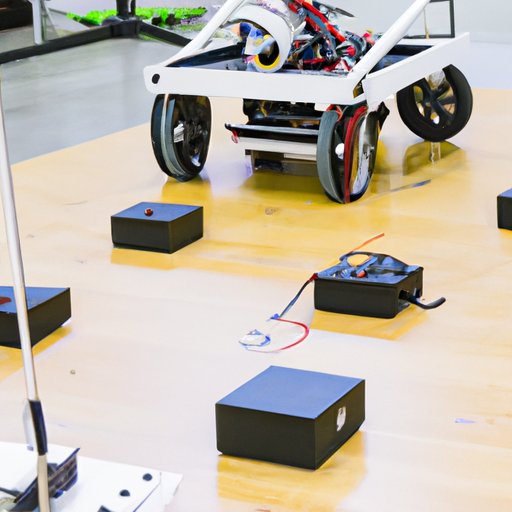Introduction
Robotics is a rapidly advancing field that has opened up new possibilities for technological development. Odometry is an important concept in robotics that enables robots to understand their environment and navigate autonomously. In this article, we will explore what odometry is, how it’s used in robotics, and its advantages and limitations.
Exploring Odometry: What It Is and How It’s Used in Robotics
At its core, odometry is a process of estimating movement. It involves using sensors, such as encoders, accelerometers, and gyroscopes, to measure the displacement, velocity, and orientation of a robot. By combining these measurements, odometry can be used to determine the position of a robot in its environment.
A Beginner’s Guide to Odometry and Its Application in Robotics
The purpose of odometry is to enable robots to estimate their location and orientation in an environment. This allows them to move around autonomously and accurately calculate their position relative to other objects. There are several components to odometry, including estimating position, velocity and orientation.
Estimating Position, Velocity and Orientation
In order to accurately estimate position and orientation, odometry must measure the distance traveled and the direction of travel. This requires the use of two types of sensors: encoders and inertial measurement units (IMUs). Encoders measure the distance traveled by measuring the rotation of wheels or other moving parts, while IMUs measure the direction of travel by measuring the acceleration and angular velocity of the robot.
Types of Odometry
There are two main types of odometry: dead reckoning and visual odometry. Dead reckoning uses encoders to estimate the displacement of a robot, while visual odometry uses cameras to track the movement of an object in the environment. Visual odometry is more accurate than dead reckoning, as it can take into account changes in the environment, such as obstacles.
Common Uses of Odometry
Odometry is commonly used in robotics for navigation, path planning, and obstacle avoidance. It is also used in robotic mapping and localization, where it can help robots build a map of their environment and identify their location within it. Additionally, odometry can be used to detect and avoid obstacles and plan paths around them.

Understanding Odometry: The Basics of Robot Motion Estimation
In order to understand how odometry works, it is important to first understand the principles behind it. Odometry relies on the ability to measure changes in the position, velocity, and orientation of a robot. This is done through the use of encoders, which measure the rotation of wheels or other moving parts, and IMUs, which measure the acceleration and angular velocity of the robot.
Using Encoders to Measure Movement
Encoder data is used to calculate the distance traveled by a robot. This is done by measuring the number of rotations of a wheel, or the amount of linear displacement of a part. This data can then be used to calculate the total distance traveled by the robot. Additionally, encoders can be used to measure the velocity of a robot, which is useful for navigating around obstacles or planning paths.

How Odometry Powers Autonomous Navigation in Robotics
Odometry is essential for enabling robots to navigate autonomously. By using odometry to estimate the position, velocity, and orientation of a robot, it can be used to plan paths and avoid obstacles. Additionally, odometry can be used to localize a robot in its environment and build a map of its surroundings.
Odometry-Based Path Planning
Odometry-based path planning is a common method for autonomous navigation. This involves using odometry to estimate the current position and orientation of a robot, and then planning a path from its current position to its destination. This type of path planning is useful for avoiding obstacles and reaching destinations quickly and efficiently.
Challenges of Odometry-Based Path Planning
One of the main challenges of odometry-based path planning is that it is prone to errors due to inaccuracies in the measurement of position and orientation. Additionally, odometry-based path planning can be affected by environmental factors such as wind, obstacles, and terrain. To address these issues, odometry-based path planning must be combined with other methods, such as GPS, laser rangefinders, and vision-based systems.
An Overview of Odometry and Its Use in Robotics
Odometry is an important tool for enabling robots to navigate autonomously. It allows robots to estimate their position, velocity, and orientation in an environment, allowing them to plan paths and avoid obstacles. Additionally, odometry can be used for mapping and localization, allowing robots to build a map of their environment and identify their location within it.
Benefits of Odometry
Odometry is a powerful tool for autonomous navigation, as it allows robots to accurately estimate their position and orientation in an environment. Additionally, odometry is relatively inexpensive and easy to implement, making it a popular choice for robotic navigation.
Limitations of Odometry
Despite its many benefits, odometry is not without its drawbacks. As mentioned earlier, odometry can be prone to errors due to inaccuracies in the measurement of position and orientation. Additionally, odometry can be affected by environmental factors such as wind, obstacles, and terrain. For these reasons, odometry must be used in conjunction with other methods for accurate navigation.
Conclusion
In conclusion, odometry is an important concept in robotics that enables robots to understand their environment and navigate autonomously. It is used to estimate the position, velocity, and orientation of a robot, allowing it to plan paths and avoid obstacles. Additionally, odometry can be used for mapping and localization, allowing robots to build a map of their environment and identify their location within it. While odometry has many benefits, it also has some limitations that must be taken into consideration when using it for robotic navigation.
(Note: Is this article not meeting your expectations? Do you have knowledge or insights to share? Unlock new opportunities and expand your reach by joining our authors team. Click Registration to join us and share your expertise with our readers.)
